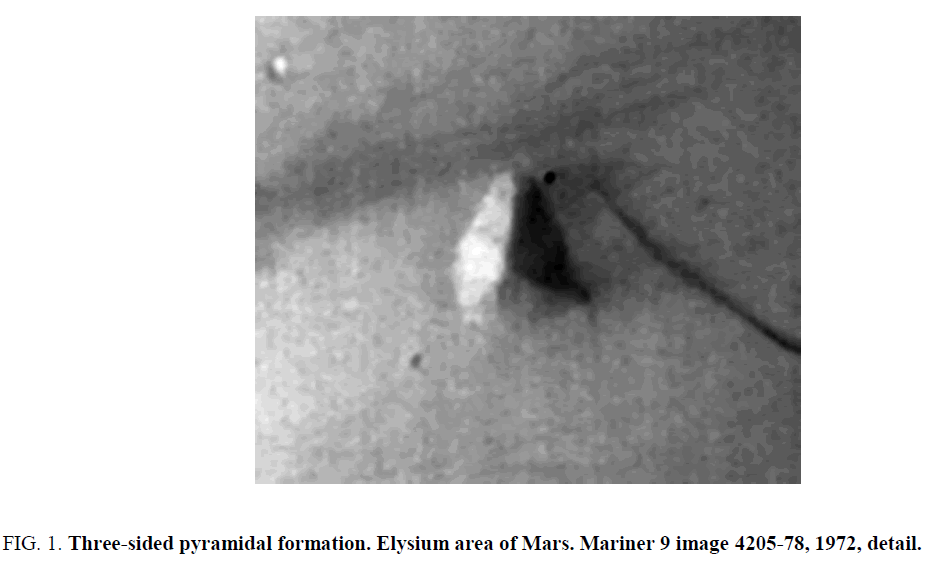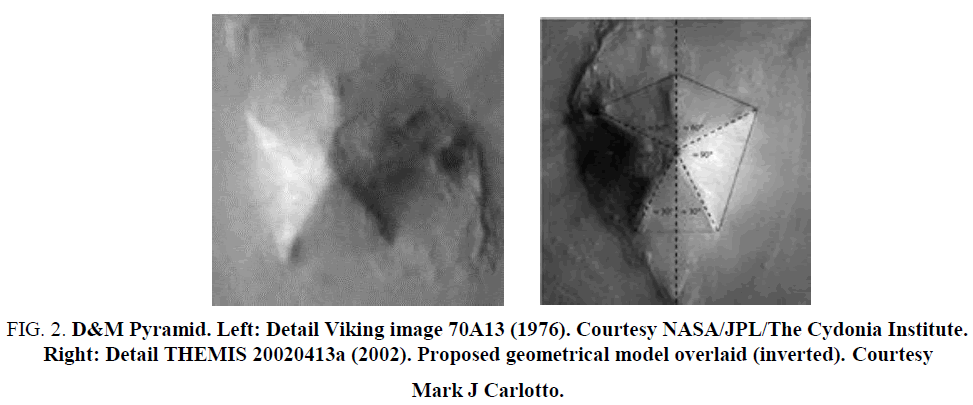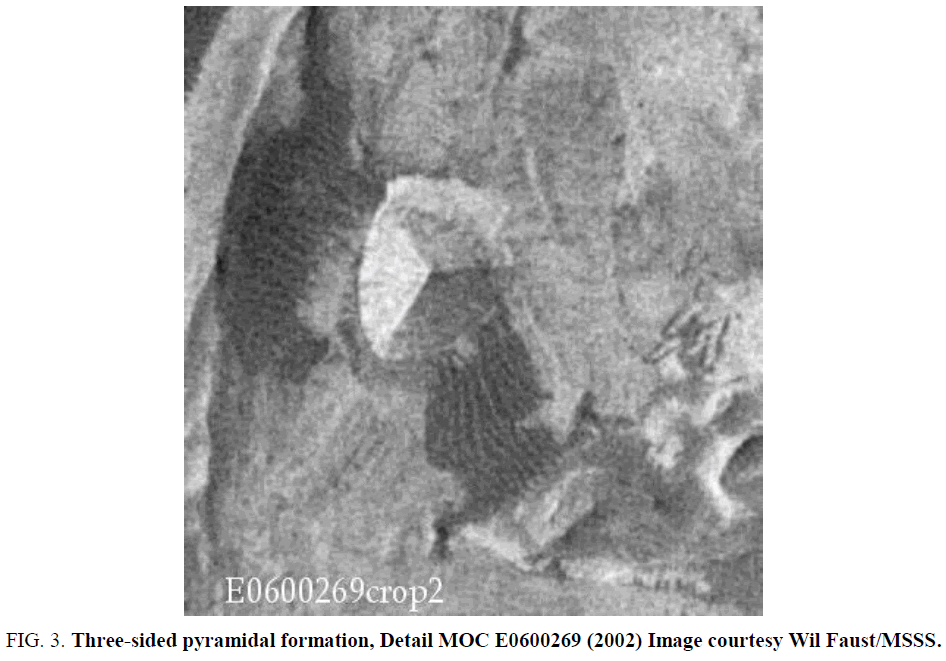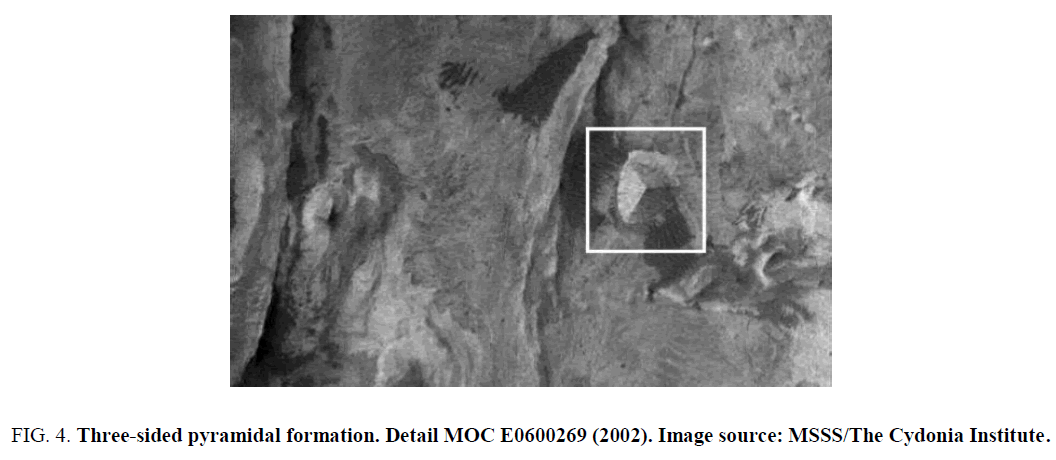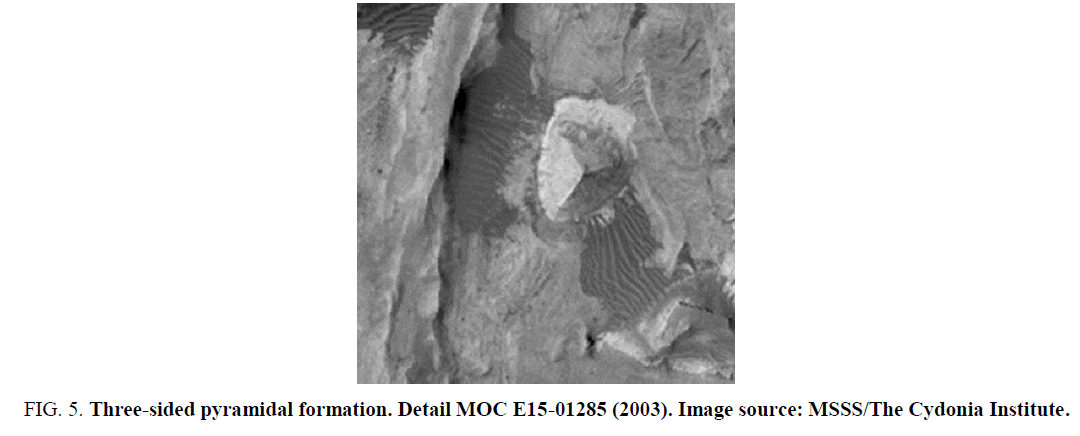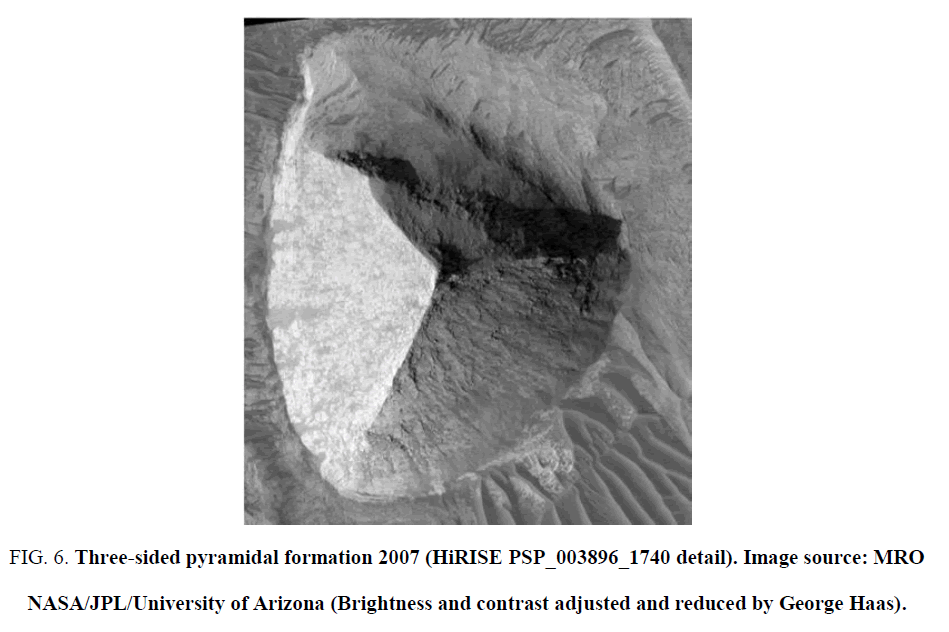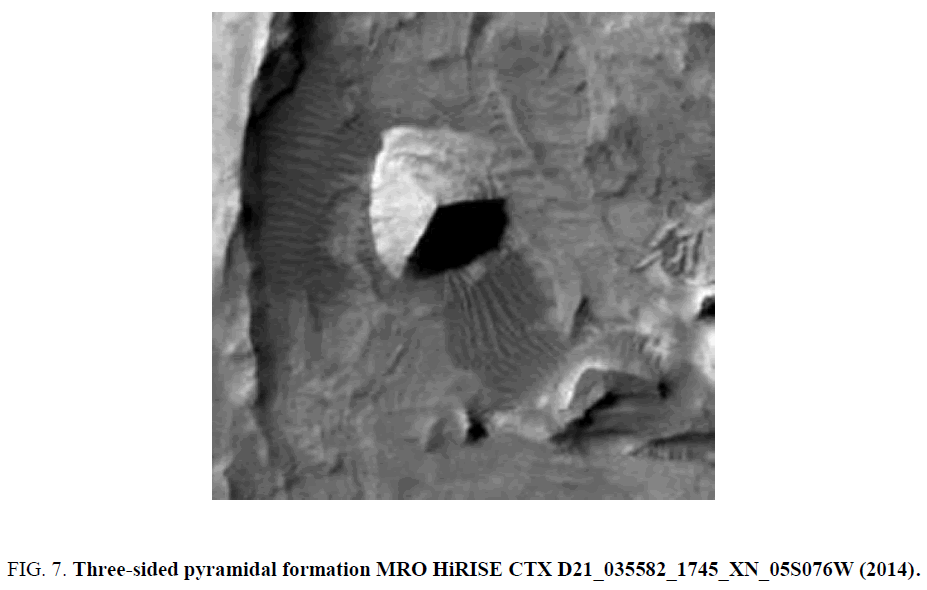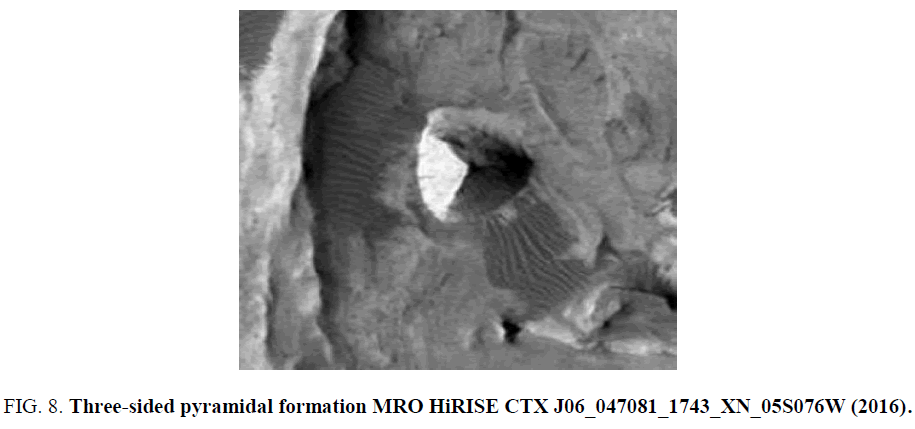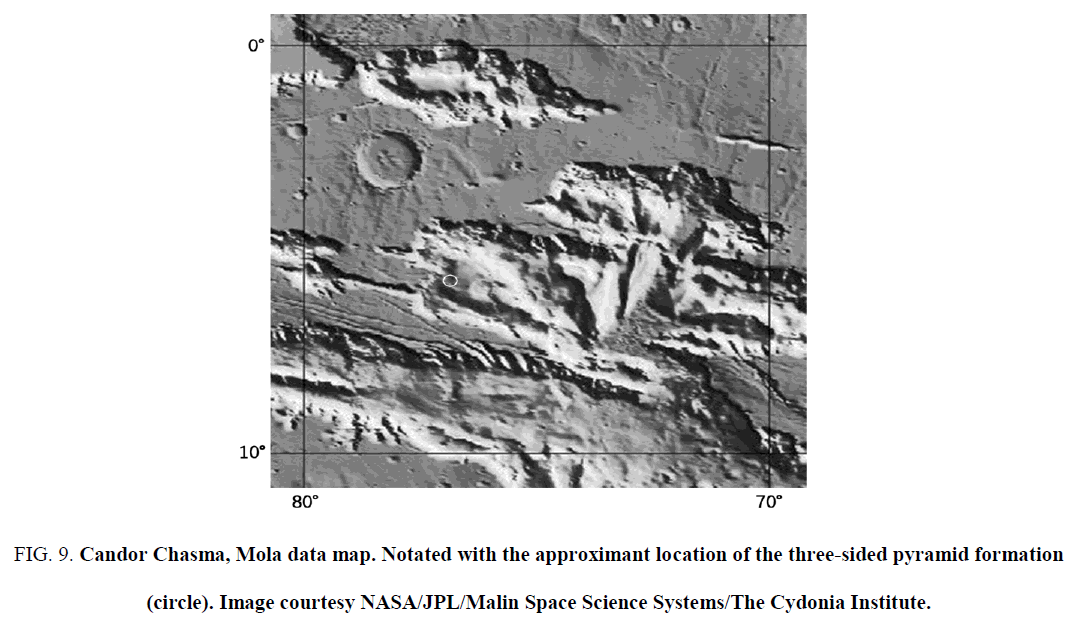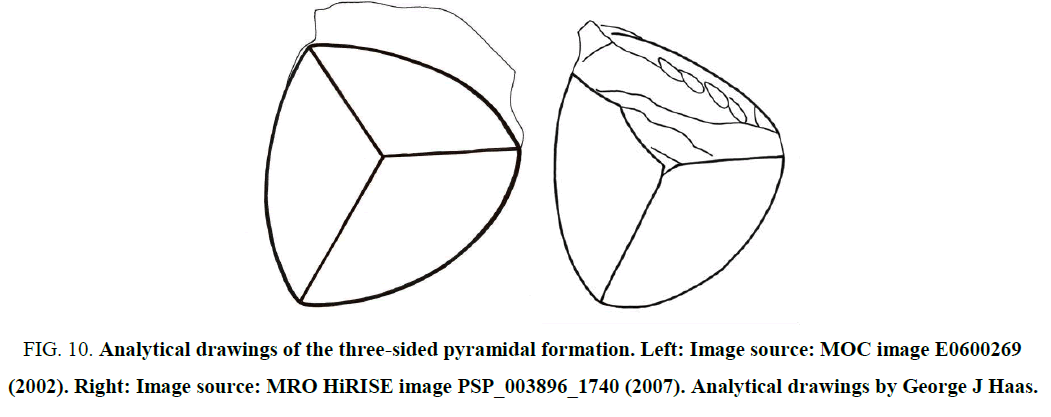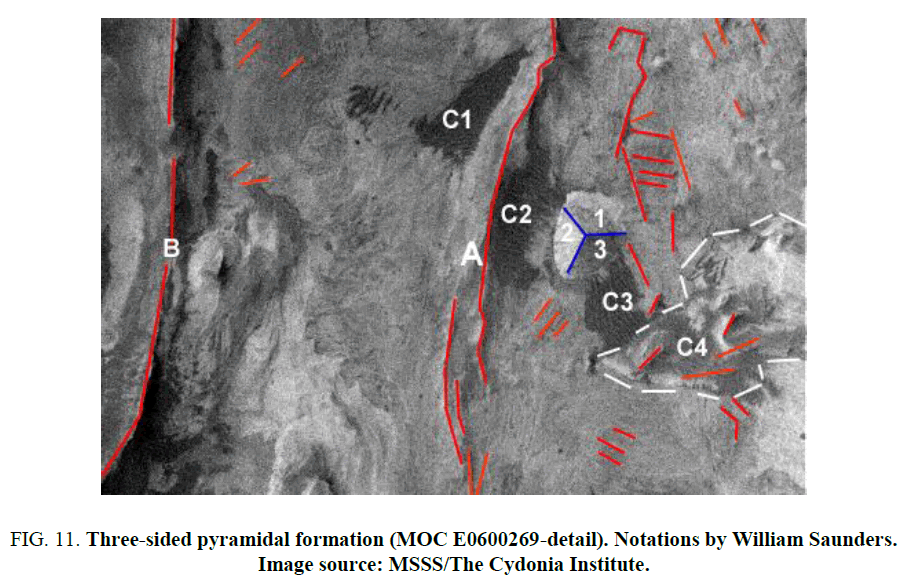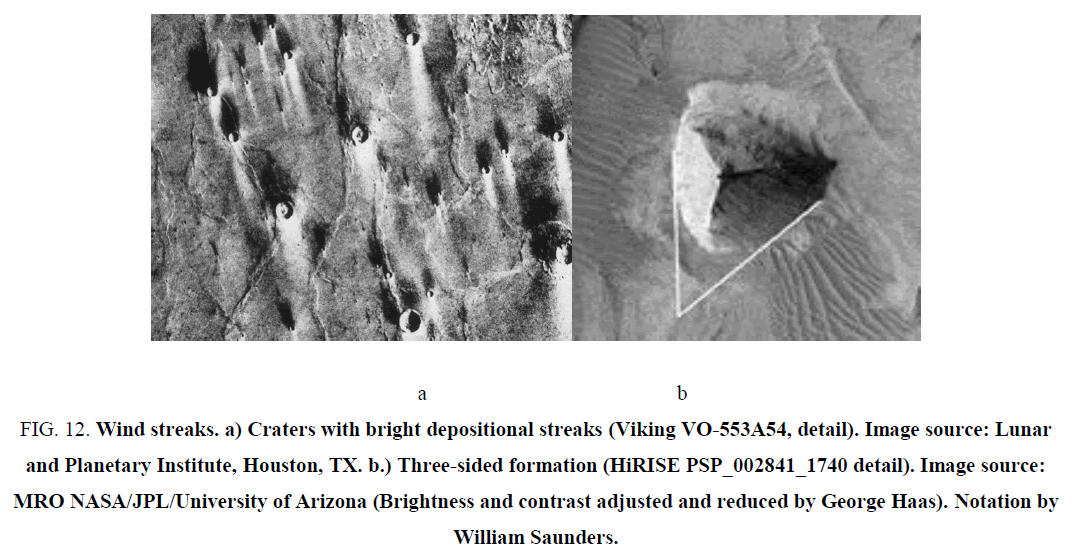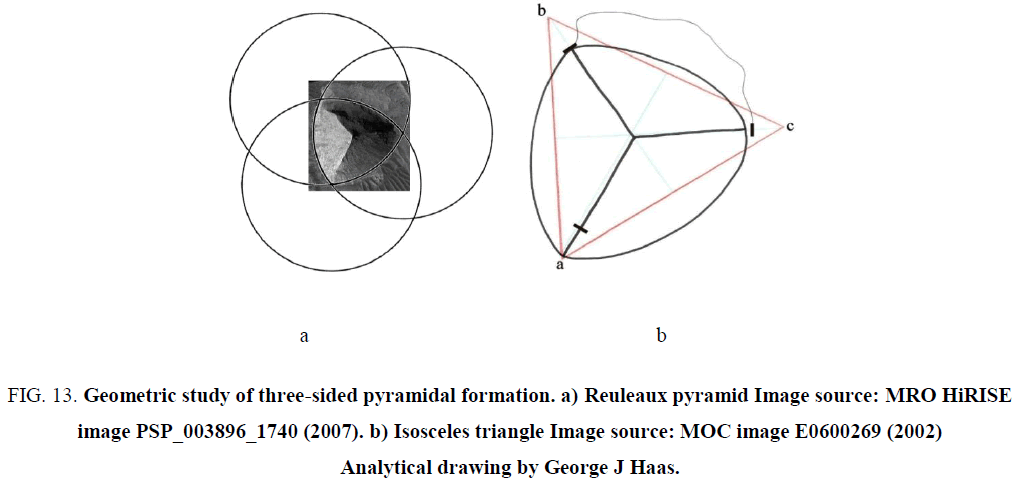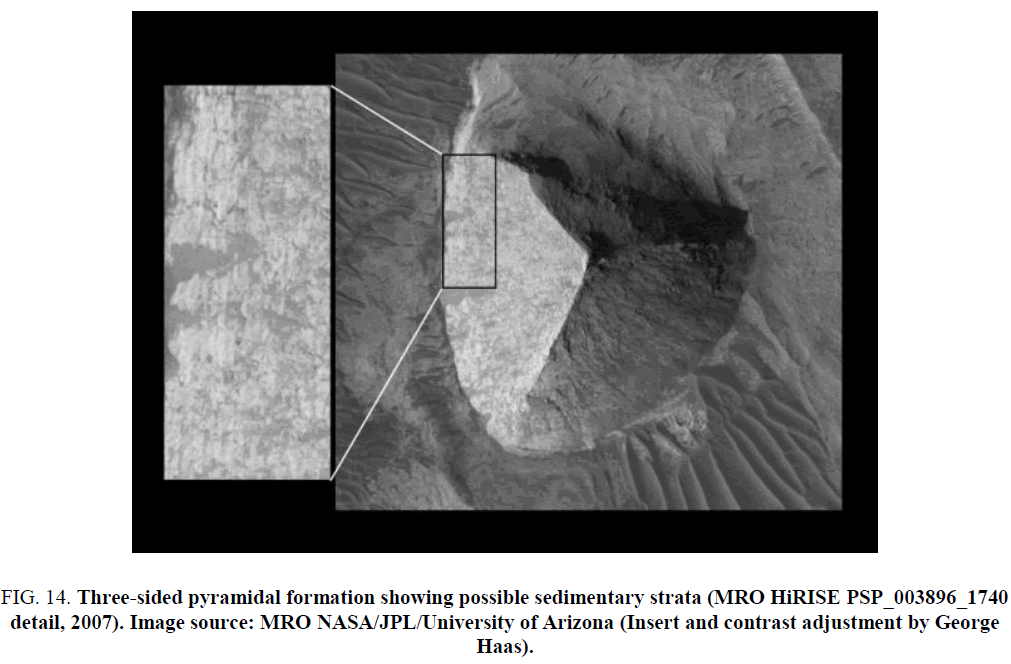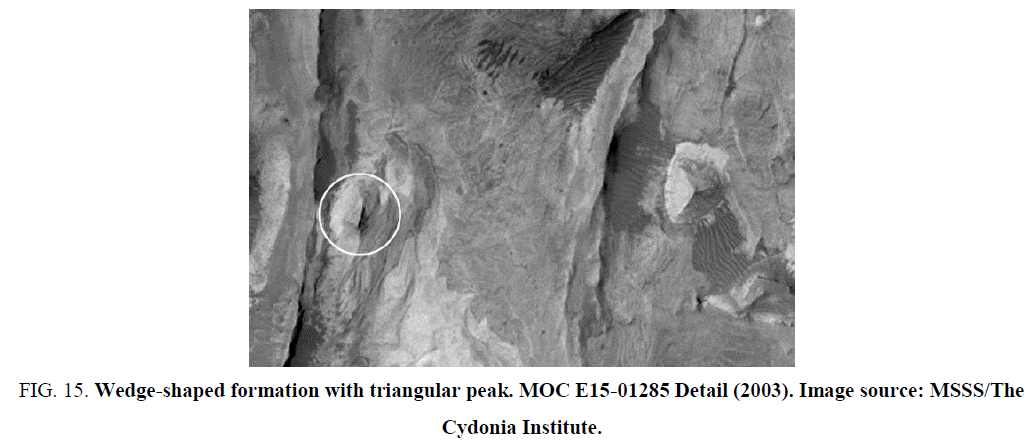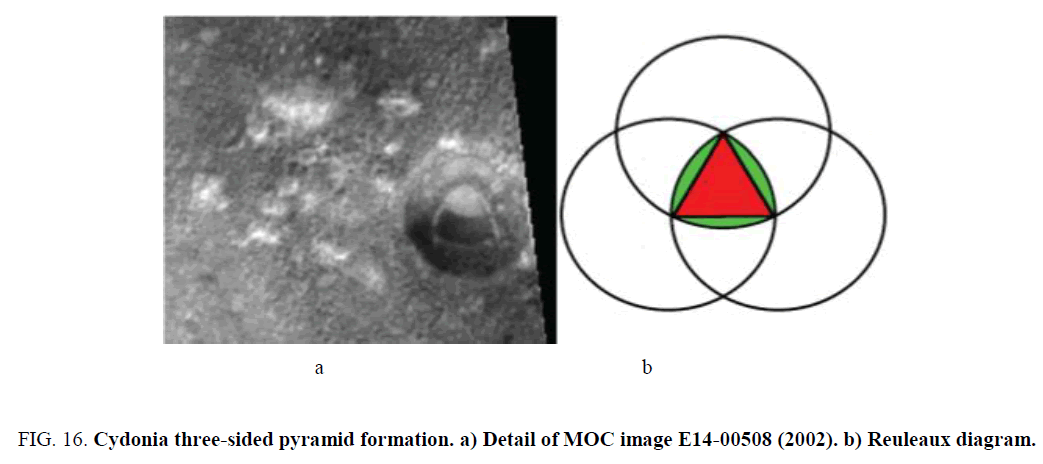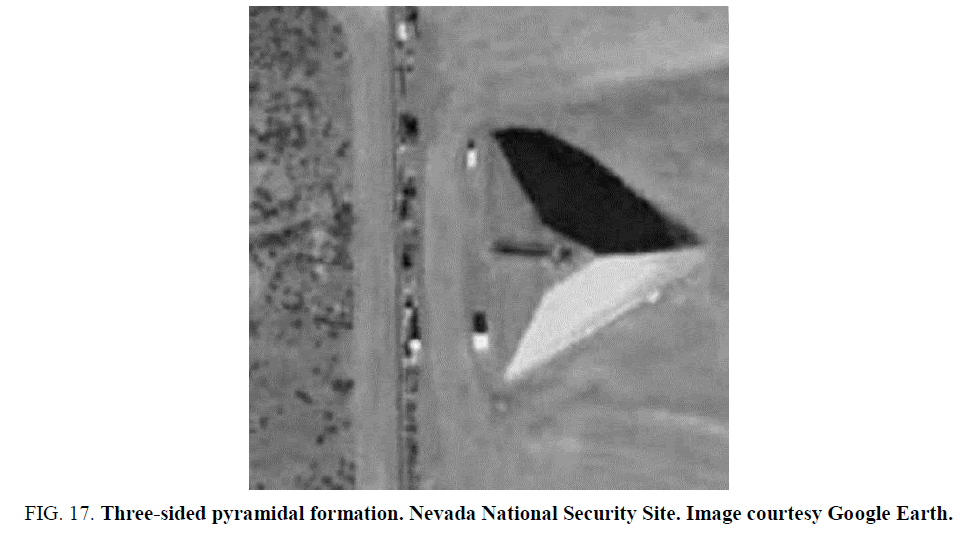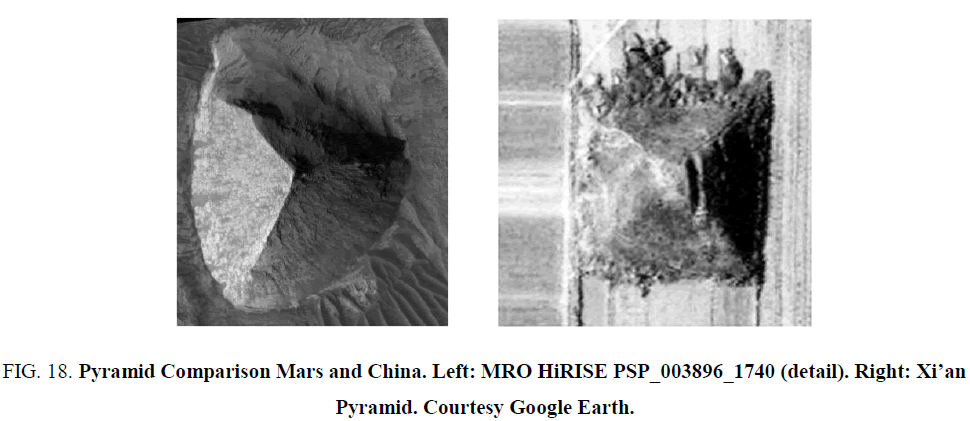Original Article
, Volume: 6( 3)Three-Sided Pyramidal Formation in the Western Region of Candor Chasma
- *Correspondence:
- Haas GJ, The Cydonia Institute, PO Box 102, Purcellville, Virginia, USA, Tel: +1 215-898-5000; E-mail: thecydoniainstitute@hotmail.com
Received: October 04, 2017; Accepted: October 23, 2017; Published: October 27, 2017
Citation: Haas GJ, Saunders WR, Miller JS, et al. Three-Sided Pyramidal Formation in the Western Region of Candor Chasma. J Space Explor. 2017;6(3):133
Abstract
A three-sided pyramidal formation located within the Candor Chasma region of Mars is examined. The formation is presented in five NASA images provided by the Mars Global Surveyor (MGS) and Mars Reconnaissance Orbiter (MRO) spacecraft. The images reveal defining aspects of the formations three-sided Reuleaux geometry, exposing a uniform symmetry in its three, triangular faces. A geologist and a geoscientist examine natural mechanisms that could contribute to the creation of the pyramidal formation and a claim of intelligent construction is proposed. An extensive search of comparable regions within and beyond the area of Candor Chasma was conducted and terrestrial comparisons are also offered. A request for additional images is recommended and a broader study of this anomalous formation is encouraged.
Keywords
Candor chasma; Cydonia; Mound; Pyramid; Reuleaux geometry; Mars global surveyor; Mars reconnaissance orbiter
Introduction
On May 30, 1971 the Mariner 9 spacecraft was launched from Cape Canaveral Air Force Station and reached the planet Mars on November 14. After months of delays caused by annoying dust storms the spacecraft was eventually able to send back over 7, 000 images of the Martian surface [1]. One image taken of the Elysium area appeared to include a three-sided pyramidal formation (Figure 1.) that caught the attention of world renowned astronomer Carl Sagan. Sagan, intrigued by the shape of the pyramidal structure, presented the image at the Royal Institution in London during his Christmas Lecture in 1977 [2]. He also featured the image in his 1980 book and television series Cosmos in which he made the following comment; “The largest Mars Pyramids have a base width of 3 km and a height of 1 km, so they are much larger than the Pyramids of Sumer, Egypt and Mexico. With the ancient eroded shape, they could be small hills, sandblasted for centuries, but they need to be viewed from nearby [3].
Figure 1: Three-sided pyramidal formation. Elysium area of Mars. Mariner 9 image 4205-78, 1972, detail.
Experimental
Between 1976 and 1980 the Viking I and Viking II orbiters obtained images and data of the Martian surface that covered the entire planet [4]. One image in particular captured in 1976 of the Cydonia region, Viking frame 70A13, [5] showed an anomalous mesa with a unique pentagonal-shape (Figure 2a) that caught the attention of two NASA scientists, DiPietro and Molenaar [6]. Titled the D&M Pyramid, after their discovery, the formation appears to express a remarkable set of common surface angles. The team remarked that “of all the observations of pyramids on Mars, we find that this one is the most unusual” [7]. On May 1, 1980 they presented their findings at a press conference held at the Ramada Inn hotel in Lanham Maryland [8] As a result they were invited to present their work in June at the Annual Convention of the American Astronomical Society in College Park, Maryland [7].
Figure 2: D&M Pyramid. Left: Detail Viking image 70A13 (1976). Courtesy NASA/JPL/The Cydonia Institute. Right: Detail THEMIS 20020413a (2002). Proposed geometrical model overlaid (inverted). Courtesy
Mark J Carlotto.
It would be over twenty-five years before a second image of the D&M formation was taken by the Mars Odyssey THEMIS camera in 2002 (Figure 2b). The THEMIS image (20020413a) is a higher resolution image that revealed a clearer view of the formation’s pyramidal shape and surface angles. After reviewing the THEMIS image an electrical engineer and digital imaging specialist Dr. Mark Carlotto proposed that the formation exhibits evidence of artificial design. He concluded the pyramidal formation is highly symmetrical and shows uniform faces measuring approximately 30°, 60° and 90° [9].
In early June of 2002 independent researcher Wilmer Faust presented an image of a three-sided pyramidal formation in the Candor Chasma region of Mars obtained in Mars Global Surveyor (MGS) image E06-00269 [10] to the first three authors of this paper (Figure 3). Faust directed our attention to a pyramidal formation with an almost circular base that had three triangular-shaped faces.
Figure 3: Three-sided pyramidal formation, Detail MOC E0600269 (2002) Image courtesy Wil Faust/MSSS.
Mgs images of the three-sided pyramid
The original image for this study was obtained via NASA’s Mars Global Surveyor web site. The Mars Global Surveyor image E0600269 was acquired during June of 2001[10]. The area examined is located in the Candor Chasma region of Mars between 5.24° south latitude and 76.83° west longitude. The formation is found towards the lower section of the long swath, about a fifth of the way up from the bottom. The area of interest is highlighted within the boxed section of the image in Figure 4.
Figure 4: Three-sided pyramidal formation. Detail MOC E0600269 (2002). Image source: MSSS/The Cydonia Institute.
In the spring of 2003 a second Mars Global Surveyor image E15-01285 (Figure 5) was acquired in by the Malin Space Science Systems (MSSS) [11].
Figure 5: Three-sided pyramidal formation. Detail MOC E15-01285 (2003). Image source: MSSS/The Cydonia Institute.
Mro HiRISE image of the three-sided pyramid
In December 2006 Planetary Scientist Dr. Catherine Weitz submitted a target request, through the MRO HiWish program to image a section of Candor Chasma that included the three-sided pyramidal formation [12]. During the spring of 2007 the Mars Reconnaissance Orbiter HiRISE camera acquired that image, PSP_003896_1740, which was released to the public in October 2007 [13] (Figure 6).
Figure 6: Three-sided pyramidal formation 2007 (HiRISE PSP_003896_1740 detail). Image source: MRO NASA/JPL/University of Arizona (Brightness and contrast adjusted and reduced by George Haas).
Two Mro Hirise Ctx images of the three-sided pyramid
The Mars Reconnaissance Orbiter camera acquired two additional images of the Candor Chasma region of Mars that included the three-sided pyramidal formation. The first is MRO HiRISE CTX image D21_035582_1745_XN_05S076W in 2014 [14] (Figure 7) and the second is MRO HiRISE CTX image J06_047081_1743_XN_05S076W in 2016 [15] (Figure 8).
Mgs and Mro ancillary data: Sun and camera angles
There are considerable differences in the telemetry, sun angle, resolution and other factors recorded in the five images; a comparison chart is presented as Table 1. The three-sided, pyramidal shape of the formation persists throughout the five images and additional features that were obscured in the first two MGS images are now visible in the MRO HiRISE images. All images are presented as they were provided through those sites to the general public with only minor size and contrast adjustments.
| Image # | E060269 | E15-01285 | PSP_003896_1740 | D21_035582_1745_XN_05S 076W | J06_047081_1743_XN_05S 076W |
|---|---|---|---|---|---|
| Acquisition Date | 04-Jul-01 | 24-Apr-02 | 27-May-07 | 28-Feb-14 | 12-Aug-16 |
| Release Date | 07-May-02 | 04-Apr-03 | 10-Oct-07 | NA | NA |
| Local Time | 10:05.8PM | 6:07:01AM | 3:16PM | 2:11AM | 1:11AM |
| Image scale | 5.73 m/pixel | 6.00 m/pixel | 26.0cm/pixel | 5.29m/pixel | 5.3m/pixel |
| Longitude | 76.83?W | 76.73?W | 283.5?E | 283.4?E | 283.49?E |
| Latitude | 5.24?S | 6.04?S | 5.8?S | 5.59?S | 5.73 ?S |
| Emission Angle | 0.16? | 17.79? | 0.8? | 3.31? | 4.89? |
| Incidence Angle | 40.56? | 22.70? | 50? | 57.98? | 50.91? |
| Phase Angle | 40.50? | 23.03? | 49.6? | 55.46? | 55.8? |
| North Azimuth | 93.02? | 93.05? | 97? | 277.09? | 277.05? |
| Range to Target | 381. km | 399.10km | 260.1km | NA | NA |
| Image Skew Angle | NA | NA | NA | 90.1? | 90.2? |
| Sun Azimuth | 2.96? | 20.87? | 155.00? | 221.64? | 179.57? |
Table 1: Ancillary data for Mars global surveyor, Mars reconnaissance orbiter HiRISE and CTX.
The first Mars Global Surveyor image E06-00269 was acquired on July 4, 2001 and released to the public on May 7, 2002. The image was taken during the summer in the late evening (10:05 PM) with a resolution of 5.73 meters per pixel (Figure 4). The sun comes in from the west, illuminating the western face of the formation, exposing its triangular shape. The northeastern face is slightly shaded while the southeastern face appears in soft shadow. A second Mars Global Surveyor image of the formation E15-01285 was acquired during the spring season in the late morning hours (6:07 AM) of April 24, 2002 and not released until almost a year later on April 4, 2003 with a resolution of 6.00 meters per pixel (Figure 5). The sun illuminates the western face of the formation while the northeastern and southeastern faces have an even tonality.
The Mars Reconnaissance Orbiter HiRISE image that included the three-sided pyramidal formation, PSP_003896_1740, was taken during the spring in the late afternoon (3:16 PM) on March 7, 2007 and released on October 10, 2007 with a resolution of 25 centimeters per pixel (Figure 6). The sun illuminates the western face of the formation, causing long shadows across the north-eastern side, while muting the tone of the south-eastern side. All of the images in this study reveal defining aspects of the formations three-sided geometry, exposing a uniform symmetry in its surrounding faces.
The first Mars Reconnaissance Orbiter HiRISE CTX image, D21_035582_1745_XN_05S076W, was acquired on February 28, 2014. The image was taken during the winter, in the early morning hours (2:11 AM) with a resolution of 5.29 meters per pixel (Figure 7). The sun illuminates the western face of the formation causing the southeastern side to appear in total darkness, highlighting the triangular shape of its face. The second Mars Reconnaissance Orbiter HiRISE CTX image, J06_047081_1743_XN_05S076W, was acquired on August 12, 2016. It was taken during the summer in the early morning hours (1:11 AM) with a resolution of 5.3 meters per pixel (Figure 8). The sun illuminates the western face of the formation while the northeastern and southeastern faces appear evenly shadowed.
Results and Discussion
The geological context for the three-sided pyramidal formation
West Candor Chasma is part of the vast canyon system of the Valles Marineris region of Mars. It is located just below the equator in the western hemisphere between 5° and 7° south and 75° and 77° west (Figure 9). The canyon is bordered on the north and south sides by straight-walled cliffs. Evidence of landslides are common on the north side forming reentrants filled with debris while the southern wall shows “spur-and-gully morphology” along with smooth sections. The western side of the canyon is defined by two cliffs extending toward the north and northeast [16]. Alteration of the canyon’s interior consist of layered deposits of basaltic flow material, hummocky material, landslide deposits, possible geothermal processes [17] and mass wasting.
Figure 9: Candor Chasma, Mola data map. Notated with the approximant location of the three-sided pyramid formation (circle). Image courtesy NASA/JPL/Malin Space Science Systems/The Cydonia Institute.
Topography and morphology for the tree-sided pyramid
The purpose of this segment is to assess the geometry of the three-sided, pyramidal formation in question and determine what natural processes are needed to create its form and structure. The feature is located within a canyon in the southwestern section of Candor Chasma. The regional overview provided in the Mars Orbital Camera (MOC) image E06-00269 (Figure 4) and E15-01285 (Figure 5) reveals the formation is positioned within the canyon floor with flow patterns of dark material in a southeastern direction from the west and south faces of the pyramid. The size of the formation is approximately 49 pixels in diameter, which is equal to 290 meters (5.84 meters per pixel). That is 951.44 feet or just under 1/5th of a mile across and approximately 145 meters high or 476 feet. The sun comes from the left and the formation is seen from almost directly overhead.
The first MOC image E0600269 (Figure 10a) displays the most symmetry of the four images. With the aid of an analytical drawing the arching curvature of the base can be seen on all three sides and its exposed faces are curved while the angles are clearly defined and intersect along a straight edge. The three faces of the formation consist of three equally spaced triangles that meet around a central vertex forming interior angles of 120 degrees equaling a total of 360 degrees. The east and west sides show bilateral symmetry with identical right-angle triangles fitting within its configuration (Figure 10a ). When accessing an analytical drawing of the second MRO imagine PSP_003896_1740 (Figure 10b) we see similar symmetry due in part to the almost straight overhead camera angle that is very close to the original MOC image E0600269 (Figure 10a). The MRO image (Figure 10b) shows an arching base line along the western and southeastern sides while the western face of the formation appears to be smoother than the other two faces. This is possibly due to the direct sun light coming in from the west. The northeastern face demonstrates evidence of some erosion that graduate to the left edge of the pyramid.
Figure 10: Analytical drawings of the three-sided pyramidal formation. Left: Image source: MOC image E0600269 (2002). Right: Image source: MRO HiRISE image PSP_003896_1740 (2007). Analytical drawings by George J Haas.
The area of study for this section of the analysis is the approximate 1750 meters by 2450 meters visible in the E0600269 MOC image. No larger regional analysis is included here. Two large ridges, marked A and B in Figure 11 trend in a general north – south direction but gently arc in opposite directions. The ridges have sharp apexes with nearly continuous linear extent. A few small, ridges of limited extent are highlighted in red to indicate their multi-directional makeup. This would indicate the area was geophysically active at some point with extensive, multi-directional fracturing and faulting. The heterogeneous appearance of the area within the white dashed lines is likely the result of a mass debris flow.
Figure 11: Three-sided pyramidal formation (MOC E0600269-detail). Notations by William Saunders. Image source: MSSS/The Cydonia Institute.
The pyramid feature is flanked to the northwest and southeast by what appears to be Aeolian sands. The shallow rise on the north-northeast side of the ridge dunes indicate saltation and wind direction from that general direction. This may account for some of the blowout found on the northeast side of the pyramid structure and may have aided as source material for some of the transverse Aeolian sand deposition marked C1, C2, C3 and C4. These dunes appear to be multi-directional in C1 and relatively linear in C2 and C3. The deposition of the dunes marked C4 are multi-directional due to the underlying surface features, however is very inconsistent in its coverage. The pyramidal structure marked 1, 2 and 3 has three ridge lines forming three faces two of which have smooth surfaces. The north face marked number 1 has an uneven surface with evidence of material having broken away and lying at the base. This collapse must be relatively recent due to the sharp uneroded edges and none of the darker, wind-blown material appears to be present as seen in C4. The structure of dune development on either side of the pyramidal feature shows the wind direction from the north-northeast. What is unusual is that there are no wind streaks around the south buttress of the pyramidal structure such as seen in Figure 12a.
Figure 12: Wind streaks. a) Craters with bright depositional streaks (Viking VO-553A54, detail). Image source: Lunar and Planetary Institute, Houston, TX. b.) Three-sided formation (HiRISE PSP_002841_1740 detail). Image source: MRO NASA/JPL/University of Arizona (Brightness and contrast adjusted and reduced by George Haas). Notation by William Saunders.
As observed in Viking Orbiter image VO-553A54 [18] of the Hesperia Planum region of Mars (Figure 12a) wind has caused bright depositional streaks to form on the leeward side of an object. This feature would be expected to be absent in the exposed areas around the three-sided formation and found within the V-shaped area in Figure 10b.
The arching curvature of the base line of the three-sided pyramid at Candor Chasma forms a Reuleaux pyramid. The three-sided formation has three vertices with curved faces that are constant in width between points a, b and c (Figure 13a). The vertices labeled a, points in a south-western direction, while the vertices labeled b points in a north-western direction and the vertices labeled c points east. Its three faces can be formed by the intersection of three circular disks, each having its center on the boundary of the other two. The imprint of an isosceles triangle is created between the vertices at points, a, b and c. showing that the north base, between point b and c is shorter than the other two sides (Figure 13b). While measurements placed upon a two-dimensional image cannot be expected to be accurate we can gather some information from the exercise. We note that we do indeed have two equal faces of the pyramid, within the western side and the southeastern side while the third northeastern face is degraded. We also readily see that the base of the formation is rounded; this is evident even through the debris fan on the north side, between point b and c, expands beyond the actual base outline.
Figure 13: Geometric study of three-sided pyramidal formation. a) Reuleaux pyramid Image source: MRO HiRISE image PSP_003896_1740 (2007). b) Isosceles triangle Image source: MOC image E0600269 (2002) Analytical drawing by George J Haas.
Mountains are formed in three ways, through volcanism, plate tectonics (folding) and block faulting. The geomorphology of the three-sided pyramidal formation observed at Candor Chasma is an enigma. It has none of the characteristics of these known processes. It stands alone in its location and form.
Mars, like Earth, hosts an extensive sedimentary record of mound creation. However, the origin of sedimentary mounds on Mars is a major unresolved question [19]. A member of the Department of Geophysical Sciences, Edwin S. Kite at the University of Chicago, Chicago, Illinois has proposed two working models for how Martian mounds may have been formed [20]
The first model includes craters and canyons that are fully filled by flat-lying or shallowly dipping strata with playa-deposits or fluvio-deltaic deposits that are exposed to extensive erosion by the effects of wind erosion over long periods of time. The model suggests that main cause of non-horizontal layer-orientations is caused by soft-sediment deformation, tectonics and differential compaction [20].
The second model shows the downslope layer-tilts are primary. It proposes that mounds grew in place by net deposition of layers on preexisting topographic highs. This distinctively Martian mechanism is suggested by that growth of polar ice/dust/sand mounds by anticompensational stacking. It notes the importance of aeolian sediment transport and slope-winds on modern Mars and the strong inference of layered sediment accumulation via anticompensational stacking for some Mars equatorial layered sediments. The model reveals that dry conditions bring aeolian processes to the fore, whereas vigorous and sustained fluvial erosion would inhibit mound construction [20].
Kite concludes that anticompensational stacking corresponds to a paleoenvironment where fluvial sediment transport is infrequent and consistent with models of Mars paleoclimate [20]. Examining the three triangular faces of this pyramidal formation (Figure 14) in the MRO HiRISE orbiter image, which has a resolution of 25 centimeters per pixel, the southern face appears to be formed by firm, compact soil. The northern face is degraded and crumbling into its base. The western face appears to be composed of a smooth consolidated material. It also contains horizontal layering indicative of sedimentary stratigraphy at the lower portion of the formation.
Figure 14: Three-sided pyramidal formation showing possible sedimentary strata (MRO HiRISE PSP_003896_1740 detail, 2007). Image source: MRO NASA/JPL/University of Arizona (Insert and contrast adjustment by George Haas).
If this layered feature is indeed evidence for sedimentary strata one has to wonder how lacustrine or marine deposition could have been eroded away in the entire area leaving a highly symmetrical three-sided mountain in its wake. The strata also demonstrate a consistent thickness indicating that perhaps they are not depositional material but may actually be the remnants of casing stones [21] used in construction of the pyramidal formation.
Presented with a pyramidal formation at Candor Chasma that has been exposed to an extensive period of environmental forces that have potentially caused the erosion and degradation of its original form, this formation exhibits remarkable symmetry. Symmetry, in nature, is found in biological systems whereas inanimate objects exposed to environmental forces trend towards random and asymmetrical forms.
Comparable pyramidal formation on Mars
Looking directly across from the three-sided pyramid, in MOC image E15-01285, on the western side of the strip is a wedge-shaped mound with a triangular peak (Figure 15). The western face of the three-sided pyramid is in direct alignment with the wedge-shaped mound. The structural form of the wedge-shaped mound appears eroded and half buried at the base of a dense ridgeline that sets within a highly textured terrain (Figure 15).
Figure 15: Wedge-shaped formation with triangular peak. MOC E15-01285 Detail (2003). Image source: MSSS/The Cydonia Institute.
When the geometry of the three-sided pyramidal formation observed in the Candor Chasma region of Mars (Figure 3) is compared to the proposed pentagonal geometry of the D&M pyramid, located in the Cydonia region of Mars (Figure 2), both formations exhibit remarkable symmetry. The interior design of the D&M pyramid contains angles measuring approximately 30°, 60° and 90° that suggest the faces can be described by isosceles and right triangular facets. Although both formations present a high degree of bilateral symmetry they show signs of erosion and degradation and are not complete. The three-sided pyramid formation at Candor Chasma lacks a clearly defined third face at its base (Figure 3) while the D&M pyramid at Cydonia (Figure 2) shows a difference between the left and right "arms" of the formation and its eastern side appears collapsed [9].
In March 2002 a circular mound with a three-sided pyramidal form was photographed in the southern region of Cydonia, not far below the D&M Pyramid. The Mars Global Orbiter image MOC E14-00508 [22] (Figure 16a) shows a three-sided formation with a curvature base line that is constant with an equilateral triangle and all points on each face are of equal distant from the opposite vertex conforming to the geometry of a Reuleaux pyramid (Figure 16b). The geometry of the Cydonia formation is consistent with the three-sided pyramidal formation at Candor Chasma (Figure 13).
Figure 16: Cydonia three-sided pyramid formation. a) Detail of MOC image E14-00508 (2002). b) Reuleaux diagram.
Cultural reference
The three-sided pyramidal formation at Candor Chasma appears to be the result of an altered construct rather than a natural process. Three and four-sided pyramidal shapes are the most durable forms of construction and their modeled triangular faces are not the product of random occurrence in a natural environment. Natural pyramidal formations tend to have conical shapes absent of equal and similar faces. They are commonly thick, truncated mounds or tall slender cones that have a round base with a pointed apex [23].
We are all familiar with the enormous four-sided pyramids produced by the ancient Sumerians, Egyptians and the Maya. However, the architectural construction of a three-sided pyramid is extremely rare. With the advent of Google Earth obscured pyramidal formations that were once unknown to the general public have recently been revealed in the Nevada desert and the remote plains of China.
The Nevada pyramid is part of the Big Explosives Experimental Facility that is located within the restricted area of the Nevada National Security Site (Figure 17). This triangular formation is a modern earthen mound; referred to here as a berm [24]. The berm has three triangular faces that are constant in width and a flat, triangular peak.
Figure 17: Three-sided pyramidal formation. Nevada National Security Site. Image courtesy Google Earth.
The pyramids found in China are four-sided and are located near the city of Xi'an, on the Qin Chuan Plains in the Shaanxi Province of central China [25]. When an aerial shot of one of these pyramids is compared to the three-sided pyramidal formation at Candor Chasma it becomes clear that the eroded condition the Martian pyramid is quite comparable to the crumbling remains of the pyramid at Xi’an (Figure 18).
Figure 18: Pyramid Comparison Mars and China. Left: MRO HiRISE PSP_003896_1740 (detail). Right: Xi’an Pyramid. Courtesy Google Earth.
Conclusion and Recommendations
The three-sided pyramidal formation observed within the western region of Candor Chasma is persistent as shown by five images in this study which were taken by two different NASA spacecrafts at five different times over a fifteen-year period. The formation is accurately depicted in two Mars Global Surveyor (MGS) images E06-00269 and E15-01285 and in three Mars Reconnaissance Orbiter images, which include MRO HiRISE image PSP_003896_1740 and two MRO HiRISE CTX images D21_035582_1745_XN_05S076W and J06_047081_1743_XN_05S076W. Within this data set of images, the structural design of the three-sided pyramid remains exceptional in regard to its geometry and symmetry. The continuity of architectural references is expressed within comparative monuments produced by modern engineers and found in ancient cultures such as China, where a common aesthetic is supported.
The presented collection of MOC and MRO images show the three faces of this three-sided pyramidal formation are well proportioned and highly symmetrical despite the actions of natural depositional and erosional agents. While there are known geological mechanisms that are capable of creating and destroying the individual triangular faces presented in this formation, the natural creation of a three-sided pyramid seems to go well beyond the probability of chance.
Therefore, we contend that the structural form of this three-sided pyramid observed within the western region of Candor Chasma is real and exhibits a level of geometry and symmetry that supports a high probability of artificial origins. We recommend that both NASA and the imaging team at the University of Arizona direct the current Mars Reconnaissance Orbiter (MRO) spacecraft acquire addition images of this anomalous surface feature. New images should be acquired at different times of day and under various sun angles for further analysis of its three faces and segmented surface. If this formation is found to be consistent, we would encourage the pursuit of “ground truth” and recommend this site as a prime candidate for the study of potential archaeological artifacts on Mars.
Acknowledgments
The authors are grateful to Wil Faust for bringing this formation to the attention of the first three authors of this paper in 2002. We also acknowledge Society for Planetary SETI Research (SPSR) members Dr. Mark Carlotto, Dr. John Brandenburg and Ananda Sirisena for their comments and suggestions in regard to reviewing earlier drafts of this paper. Special thanks go to NASA and the University of Arizona for the use of the Mars Global Surveyor and Mars Reconnaissance Orbiter images that are available on their public web sites.
References
- Parks RJ. Mariner 9 and the exploration of Mars. Astronautical Research. 1972;1973:149-62.
- Sagan C. The Planets, Mars before Viking, Christmas Lecture, Royal Institution, BBC 2; 1977.
- Sagan C. Cosmos. Published by Random House, New York City, New York, United States;1980;129:130.
- Viking 1 and 2. NASA Mars Exploration. Program & Missions. 1975.
- http://viewer.mars.asu.edu/planetview/inst/viking/070A13#P=070A13&T=2
- DiPietro V, Molenaar G. Unusual Martian Surface Features' Mars Research, Glen Dale, Maryland; 1982.
- Carlotto M. The Cydonia Controversy, Lulu.com; 2008;p:47.
- Boeche R. Journal of the Fortean Research Center Paperbound; 2012.
- Carlotto MJ. Analysis of Mars Odyssey THEMIS Imagery of the "D&M Pyramid." New Frontiers in Science. 2002;1(3):4.
- http://www.msss.com/moc_gallery/e01_e06/images/E06/E0600269.html
- http://www.msss.com/moc_gallery/e13_e18/images/E15/E1501285.html
- https://www.uahirise.org/hiwish/view/8360
- http://hirise.lpl.arizona.edu/PSP_003896_1740
- http://viewer.mars.asu.edu/planetview/inst/ctx/D21_035582_1745_XN_05S076W#P=D21_035582_1745_XN_05S076W&T=2.
- http://viewer.mars.asu.edu/planetview/inst/ctx/J06_047081_1743_XN_05S076W#P=J06_047081_1743_XN_05S076W&T=2.
- http://mars.jpl.nasa.gov/gallery/canyons/PIA00403.html.
- Geissler PE, Singer RB, Komatsu G et al. An unusual spectral unit in West Candor Chasma: Evidence for aqueous or hydrothermal alteration in the Martian canyons. Icarus. 1993;106:380-91.
- http://www.lpi.usra.edu/publications/slidesets/winds/winds_index.shtml
- Grotzinger JP, Milliken RE. The Sedimentary Rock Record of Mars: Distribution, Origins and Global Stratigraphy. Sedimentary Geology of Mars SEPM Special Publication. 2012;102:1-48.
- Kite ES, Sneed J, Mayer DP, et al. Evolution of major sedimentary mounds on Mars: build-up via anticompensational stacking modulated by climate change. J Geophys Res. 2016;121(11):2282-24.
- Hoagland RC. It Only Takes ONE White Crow: The Real Agenda of NASA's Curiosity Mars Rover Mission, Enterprise Mission; 2013.
- http://www.msss.com/moc_gallery/e13_e18/images/E14/E1400508.html
- Scientific American: Supplement, the formation of mountains by water, the influence of erosion by water in modeling the landscape, New York; 1911.
- https://wci.llnl.gov/
- Preston S. Who Made the Pyramids? Lulu Press, Inc. Morrisville, North Carolina, United States; 2014.
